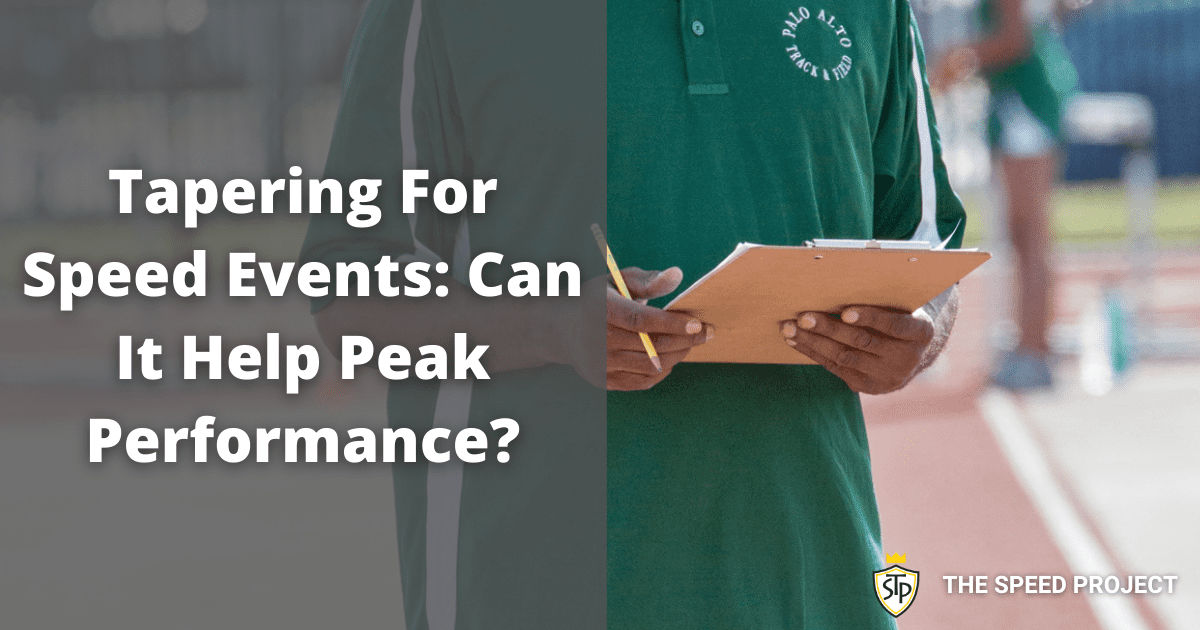A taper involves reducing an athletes training load in various ways to optimise performance. This can be for a major competition or competitions during a season.
The days leading up to competition should be managed with care. Poorly implemented tapers can potentially lead to the previous weeks, months or even years of training being wasted.
An effective taper will help you prepare for your major competitions and achieve peak performance.
The purpose of this article is to provide you with information to implement a tapering period.
What Is A Taper
Tapering is a well-established training method. It’s implemented so that athletes are able to reach peak performance at certain points during the season. Usually for major competitions.
It’s important to recognise that not all tapers are equal. Tapering for a long distance runner will look very different from that of a track sprinter.
The differences don’t end there. Even athletes running the same event may not have identical tapered training.
Coaches will have different methods. It’s impossible to determine which method is more effective as there are always varying factors.
The most important thing is that coaches focus on the individual needs of the athlete. There are however guidelines you can follow to help create your tapering period. You can then tweak as necessary.
The more experience you have (be it as a coach or as an athlete) the abler you will be to determine what leads to peak performance.
Athlete Needs Analysis
I think it’s incredibly important to monitor, assess and change your training needs in the build-up to the competition.
Athletes and coaches should take care not to make large changes in training without viable reasons for doing so. Tapering is not a magic fix but should accompany months of hard training and planning.
Note: If you have not put in the work beforehand, no type of tapering strategy will help you produce personal bests or win races.
Implementing a taper can be difficult. There are many factors to consider that can affect your competition preparation.
most importantly, the needs of an athlete may change throughout the season. Here are some things you may need to consider:
- Injuries
- Levels of fatigue
- Competition schedule
- Nutrition
- Travelling to and from competitions
- Weather conditions
To tackle these issues, I suggest doing an Athlete Needs Analysis. This is simply a breakdown of all the things that will help an athlete achieve success.
Completing a needs analysis throughout the season will provide you with valuable information. The information collected will influence your tapering program nearer the end of your season.
How To Implement A Taper
Most athletes will be looking to peak for 1-2 competitions during the season (the most important meets). Therefore it may be necessary to carry out 2 tapers.
To give you an example, the majority of my athletes look to peak at regionals and then again at Nationals. But what actual changes do you need to make in training to carry out a successful taper?
Duration Of Your Taper
One issue is knowing the length of time that you should carry out a taper.
1 week…2…more?
The answer will be different for every athlete. You have to consider multiple factors. Such as physical fitness levels, training age and of course competition schedule.
This is why a needs analysis is so vital!
In general, I would suggest starting your tapering period around 8-14 days prior to your major competition. Overall training workload should be reduced over these days.
My athletes have a busy competition schedule. This means we don’t need a long taper (we’re starting from 10 days away from Nationals).
However, if you have a long period without competition, you may need to consider starting your taper sooner.
This will allow you enough time to decrease your workload so that you have more time to get into an optimal form for your competition.
Volume And Intensity Of Your Training
During your taper, you want to gradually reduce your training volume by around 40-60%. This will allow for the body to react to hard training and make adaptations for peak performance.
Note:You are decreasing your workload, not the intensity of the work being performed!
In most cases, your training intensity will remain high, maybe even a little bit higher than usual to create an overload.
This means that you don’t necessarily need to decrease the number of sessions you have each week during your tapering period. In fact, many athletes keep this the same right up until their competition.
Personally, I reduce the amount of training for my athletes in both duration and frequency. We focus on quality race specific work. Or work that has direct race transfer such as reactive strength training.
Training During Your Taper
As mentioned above, I would suggest focused training that mimics your event type and intensity as closely as possible. For example, perform sprints at 95-100% intensity and performing exercises that focus on minimum foot contact time.
The same goes for your strength training. Focus on minimum foot contact time exercises such as bounding and sledge sprints. When weightlifting, perform explosive exercises such as the power clean and snatch.
Note: You will want to avoid any maximum strength training sessions during this period as they can be particularly fatiguing. You don’t want to cause any unnecessary stress to the body before a competition.
Priming
Often athletes perform priming sessions before or on the day of competition. The idea behind this is to promote an increase in testosterone to help enhance performance for the upcoming race.
For example, an athlete may perform 2 x 2 heavy back squats before they go out to compete. Although I wouldn’t recommend this for most athletes that are not at an elite level.
However, you can try performing a couple of explosive standing long jumps. This decreases the risk and is much easier to accommodate than trying to perform heavy squats.
Tip: Perform dynamic stretches and a light warm up the day before your competition to activate the muscles so that they are prepared. This is particularly helpful if you have been travelling.
I hope you now have a better understanding of how to implement an effective tapering strategy, good luck in your future competitions!

